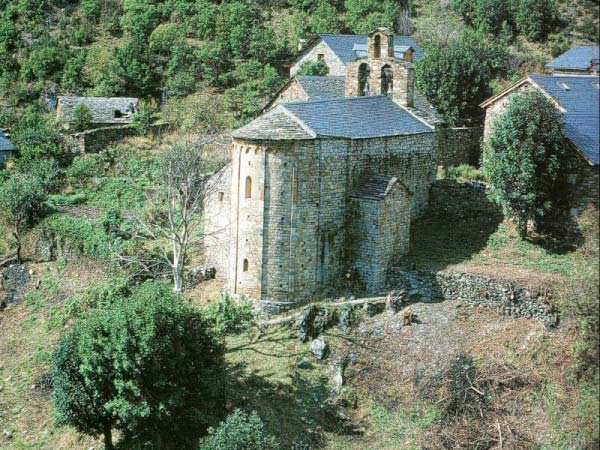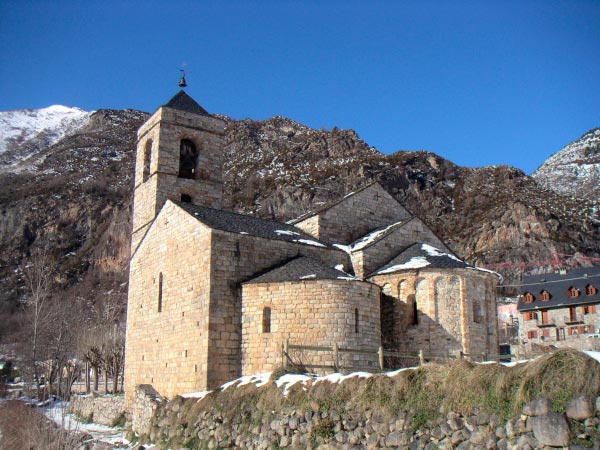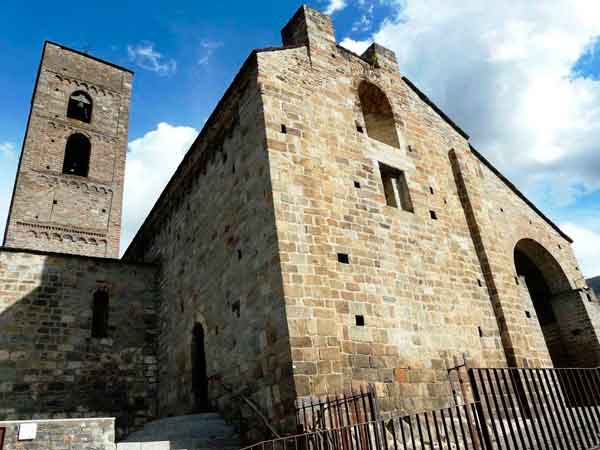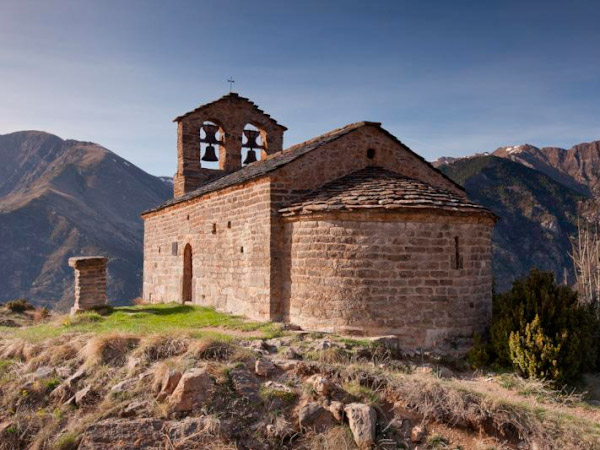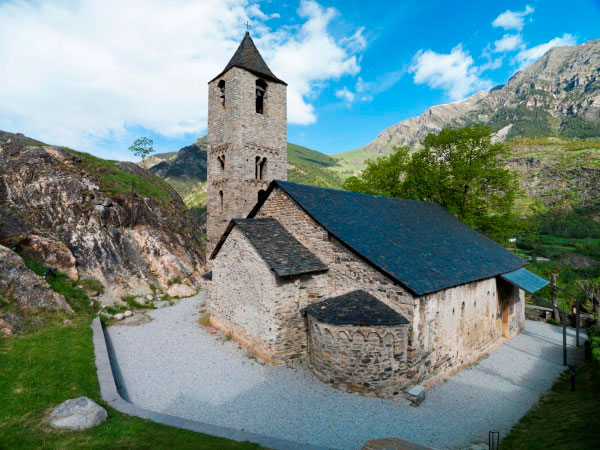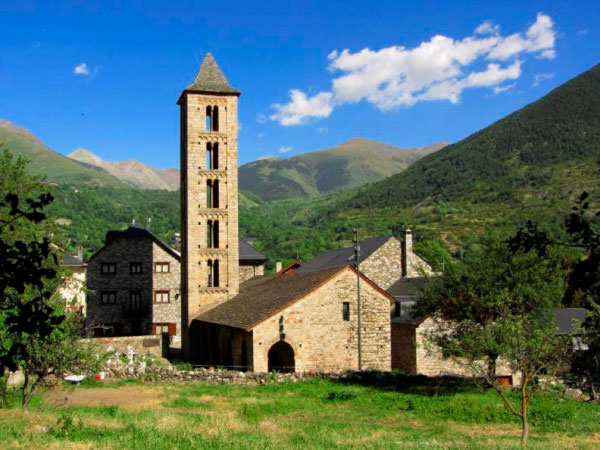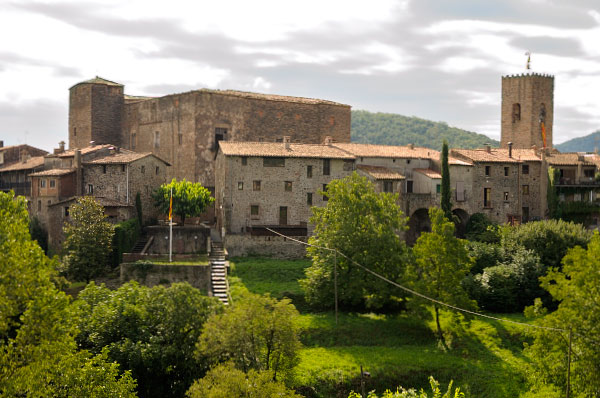
The most beautiful towns and villages in the Pyrenees
The most beautiful towns and villages in the Pyrenees
… is a post that will grow through the time.
There are a lot of remarkable villages and towns in the Pyrenees, and I’m going to classify them geographically. Otherwise, it’ll be a mess. Also, the order I’m going to follow is from right to left, or West to East – that is to say, from the Mediterranean Sea to the Cantábrico Sea.
Contents
- Eastern Pyrenees
- Catalonia
- Andorra
- France
- Central Pyrenees
- Catalonia
- Aragon
- France
- Wester Pyrenees
- Navarra and Basque country
- France
Towns and villages in the Eastern Pyrenees
Catalonia
Sant Llorenc de la Muga
Located in l’Alt Emporda County at 173 m, near La Garrotxa County, in a mountain area crossed by the Muga River. It has 230 people.
The walled medieval area is in incredibly good condition, and so are most of the houses in the ancient quartier. This is a village which invites you to wander up and down.
Some houses were built in gaps in the wall during the last few centuries. The wall has three doors and several towers, some round and some square. Also built into the wall is a church named Sant Llorenc and an irrigation channel which crosses the ancient quartier and provides water to some public and private laundries.
Outside the wall, there’s the Sant Llorenc private castle (XIII Century) and the watchtower. These two buildings, along with the wall and its towers, form a defensive system that is complex for the time it was built.
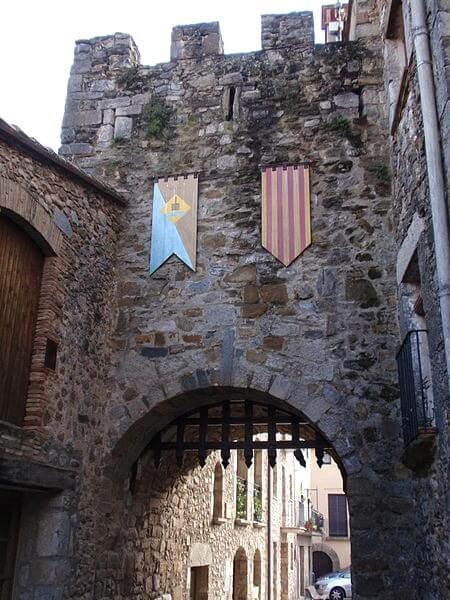
Besalu
Located in La Garrotxa County at 151 m, the village has 2,400 people.The Fluvià River flows alongside it, and has always been a kind of protection.
Besalu is one of the better preserved medieval villages of Catalonia. It is definitely not to be missed. You need almost a day to see all the religious and civil buildings, such as
Every street, square and corner of Besalu has superb architectural details that invite you to travel back to the Middle Ages.
An important Jewish congregation lived for centuries between the castle and the walls of Besalu. Recently archaeologists have discovered the old synagogue.
All guides should include Besalu as one of the most beautiful villages in the Pyrenees.

Santa Pau
The village, classed an historic and artistic monument by the Spanish government, is located in the middle of the Garrotxa Natural Park, an area full of volcanos. Nearby you can visit three: Croscat, Santa Margarida and Roca Negra.
Also in La Garrotxa county, Santa Pau is at 496m and has 1,604 people.
The entire ancient quartier deserves attention. At its highest part there is the Barony 13th-century castle. It was built on a small mound at the foot of the Finestrelles mountain range, overlooking Santa Pau valley. In 1278, after the creation of the barony, the castle became the residence of the lords of the Santa Pau jurisdiction. Later, with the 1300 franchise charter, the palace-castle became the nucleus around which the walled town grew up. The building is in the shape of a quadrangle, with rooms set around a central inner courtyard.
The old town. This section of the walled town contains the first dwellings, clustered around the baronial residence. The houses were built on uneven terrain, against the ramparts, in a single steep street leading up to a little square. The Rectory beside the castle is the most important house in this section of the town and is worth a visit.
The Main Square, located south of the castle, was the place where townspeople gathered for fairs and markets. The most outstanding feature is the rows of covered arches, built to offer shelter from inclement weather. The different styles of arches and windows reflect the evolution of local gothic architecture. This 14th-century square is one of the most charming and best preserved medieval squares of Catalonia.
Santa Maria parish church dates mainly from the 16th Century although it was started in the mid-15th century. It is an austere Gothic construction with an imposing bell tower.

Beget
The village of Beget is also in La Garrotxa, at 541 m. and has 30 people.
Beget is the village you would build if you had the chance. It is pretty, picturesque, small and charming. The whole village is effectively an historic monument. All the houses and streets are stone constructions upon the river, which is traversed by two ancient medieval well-preserved bridges.
Its Romanesque church, Sant Cristòfol, was built in the 12th Century and has an impressive bell tower. You’ll find more information about this church here
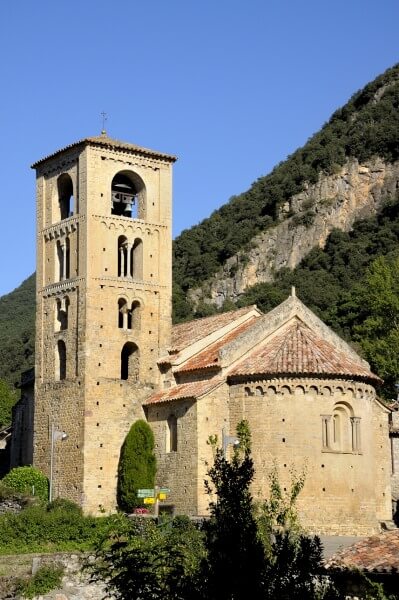
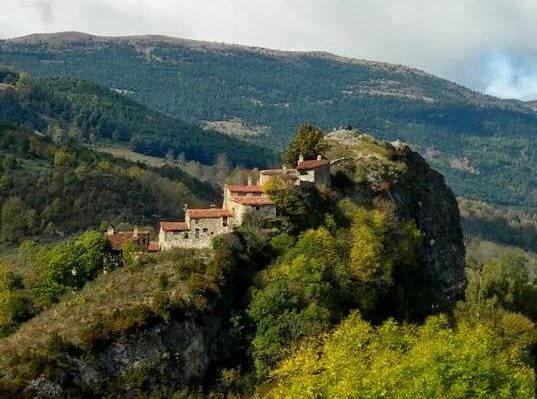
Dorria
Dorria, a tiny village in the Ripollès County, at 1,550 m, is the second highest village in Catalonia. It has 17 people, more or less.
It is located on a south slope over the Rigart River. The Catalan government has decided this village should be protected from mass tourism to preserve it as a rustic mountain village.
Some remarkable Romanesque wall paintings were discovered in 1997 in its 10th-Century Pre-Romanesque church, Sant Víctor.
Despite this discovery and the beauty of its church Dòrria struggles to survive in the face of depopulation, farm abandonment, isolation caused by tough climatic conditions, and a poor railway service between Barcelona and Puigcerda, among other factors. However, thanks to some stubborn people who want to continue making a living from crops and animals, the village survives. The famous Spanish brick crisis didn’t hit there. They are on another planet.
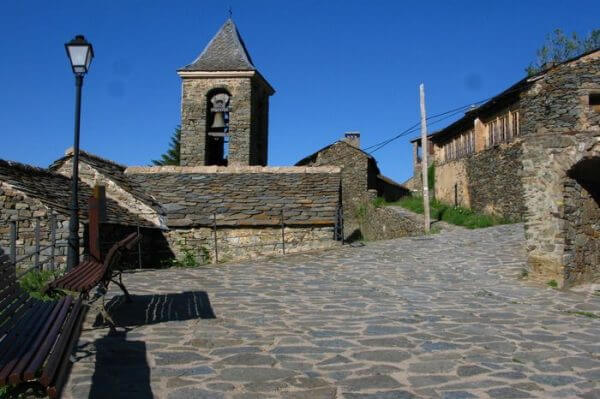
Llivia
Llivia, which belongs to La Cerdanya, is at 1,224 m and has 1,536 people. The Segre River crosses the town before arriving at Puigcerda.
Curiously, it is a village completely surrounded by French territory. Llivia was not included in the Treaty of the Pyrenees, signed by France and Spain in 1659. Due to this Treaty, the following Catalan territories were given to France: Vallespir, Capcir, Conflent, Roussillon and High Cerdanya.
Llivia has an interesting fortified enclosure, a castle and a famous 17th-century pharmacy which is open to visitors.

El Querforadat
This very small village is located at 1377m, on the north side of the Cadi Moixero natural park, in a region of the Pyrenees called Alt Urgell. It has brilliant views of la Cerdanya. Only Canejan has comparable views. Quer means in Catalan ‘rock’ and foradat means ‘pierced’.
The GR 150 trail passes by the North side of the village. The road which leads to it has seemingly endless bends. The village is located around a big crag, an ideal place in the wild, rugged landscape to sit for a while and meditate.
The heart of the village is very well-preserved, with big beautiful houses adorned with elegant balconies.
A Catalan writer, Joan Obiols, writes about the village in his work Nits de Cabaret: “… below the near-vertical cliffs, the houses are built in terraces; four or five of smallest are just on the edge of the cliff which looks across the valley”.

Castellar de n’Hug
Located in the Bergueda, a region of the Catalan Pyrenees near the Cadi Moixero Natural Park, Castellar de n’Hug has always used the local stone for its houses, so this village has always mimicked the natural environment surrounding it. When you see the village from higher up the mountain, it looks more like a painting than a real village.
Castellar is at 1400m on a ridge, surrounded by terraces used in former days to grow vegetables. The village has 167 people and is well-known for its sheep dog contest. You can visit La Casa del Pastor (The Sheperd’s house), a little museum devoted to the natural and cultural heritage of this part of the Pyrenees.
The other attraction of the village is its location near the source of the Llobregat river, which flows out to the sea at Barcelona. The source of the river is a magical spot, surrounded by an oak wood and dense vegetation.
The heart of the village is full of steep and narrow streets that are a reminder of how hard the life of a villager was in the past.
The Santa Maria church in the village is Romanesque, but I recommend visiting a better one not far away, called Sant Vicenc de Rus. It is at the side of the road between Castellar de n’Hug and La Pobla de Lillet. To learn more about Sant Vicenc de Rus click here.
Clot de Moro: Not far from Castellar, but closer to La Pobla de Lillet, there is the ancient Clot de Moro cement factory. Now a museum, it was built in 1904 by businessman Eusebi Güell, close friend and sponsor of Gaudi. It was the first Portland factory in Spain at that time.
The main building of the factory has a series of overlapping levels with stunning vaults; everything is grey. You won’t have seen anything like it before. Gaudi designed the engineers’ house at the site. The factory stopped working in 1970. There is a tourist train which goes from La Pobla de Lillet to the factory.
Ordino
Ordino is in the north of Andorra; 4,550 people live in this village at 1300m.
Generally speaking, tourism has “transformed” Andorra and it is difficult to find unspoiled places. However, the core of Ordino has been preserved and the new buildings follow the ancient building patterns: stone, wood and iron. Ordino is one of the most important urban heritage sites in Andorra.
Ordino is surrounded by peaks that reach almost 3000m. The centre of the village has only one street. The solid roofs of the houses hold heavy, though fine, chimneys.
Among the buildings I should mention the town hall, at the Plaza Major. In the same square you can visit the Ordino church, Sant Corneli i Sant Ciprià, with a fine bell tower, and a sculpture of the Virgin made in wood.
Another remarkable building is Casa Rossell, built in 1890. It has an interesting wall bell. There is disagreement about the origins of this building. Some say it is a small church, others a small convent, others an ancient bishopric. Anyway, it is a symbol of one of the richest families in the area, owner of a steel company.
Casa Areny-Plandolit: The ethnographic museum in Casa Areny-Plandolit is worth a visit. It belonged to the Areny-Plandolit family, which owned forges and mines. You can see how wealthy the family was when you visit. The house contains many excellent iron works, and a library with 35,000 volumes.

Gerri de la Sal
Gerri de la Sal belongs to Pallars Sobira County, is at 605 m and has 136 people. The Noguera Pallaresa River passes by this charming village.
Its salt pans were first exploited in the 9th century and were its main business for centuries. Nowadays some have been restored near the original salt-water spring so you can see the whole salt manufacturing process, though most were destroyed when the river flooded in 1982.
Gerri de la Sal still has the ancient walls that were its fortifications, and retains its narrow streets, watchtowers for keeping a lookout over the salt pans, arcaded areas used for markets and its medieval houses
However, the most remarkable building is the church of Santa Maria Benedictine 11th-century Romanesque monastery, located on the other side of the river, linked to the village by a medieval bridge. Only the church has been preserved from the ancient monastery. It’s so remarkable that it’s worth an entire article of its own.
The main part of the building, and the reason why many people stop in Gerri, is the frontispiece of the church, which has a three-section porch. The three-level bell wall above the porch characterizes the building.
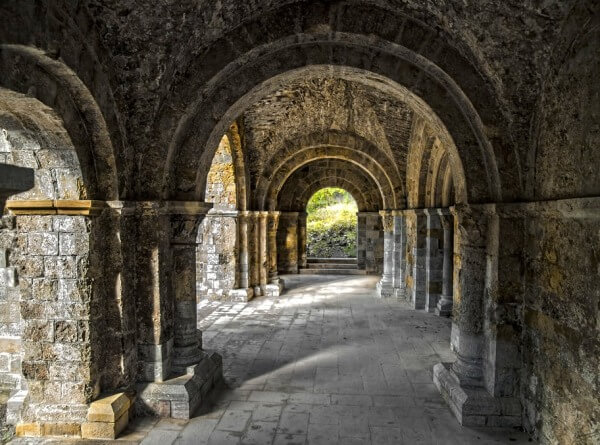
Peramea
Also in the Pallars Sobira County, it is at 905 m and has 78 people.
Peramea is a good example of a medieval fortified town where the houses are themselves part of the wall. It is built at the base of a big rock where there was once a castle, now in ruins.
Peramea has only three streets which follow the typical medieval alignment. The whole village, even the pavements, are built of stone. Two doors of the ancient wall enclosure remain to show us the medieval origins of the Peramea.
Not far from the village there’s a dolmen – a megalithic tomb.

Escalo
Also in the Pallars Sobira County, it is at 1,219 m and has 99 people.
Escaló is another example of fortified town. All the houses are built along a single street. As in Peramea, the two doors in the wall permit entry to the fortified town. Curiously, the church is outside as well as the watchtower.
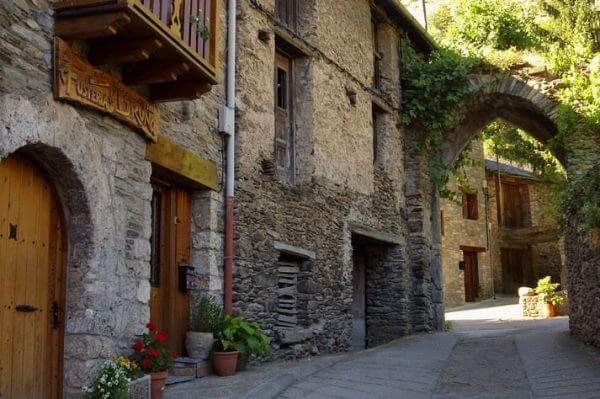
Alos d’Isil
Long ago, in the Middle Ages, the Isil valley following the bed of the Noguera Pallaresa river was like a separate country in the Pallars district. It had large forests, rich meadows and prosperous livestock.
This history can be now seen reflected in the big houses of the valley, particularly in Alós d’Isil. The village has succeeded in coping with modern times and the sometimes destructive pressure of tourism. The medieval bridge is its main symbol, used for centuries by travellers between the Occitanie (in France) and the Pallars when the paths that linked them were more suited to people and animals than any kind of vehicle.
Don’t miss Casa Dida, a big house which reminds us the power of the family who lived there. Then go to Casa el Tort, which belonged to one of the richest families of the Pallars.
Tthe Sant Lliser church in the village has a valuable Romanesque frontispiece incorporating many sculptures. Its meaning is still an unresolved enigma.
Sant Joan: In June, a popular fair is celebrated in this village — the night of Sant Joan (San Juan in Spanish), one of the most popular rites in the Pyrenees. Hundreds of people carry pinewood torches down the mountain path, creating the spectacle of hundreds of descending fires. Not to be missed!
It is an anthropological and visual performance which tells a story about the cycle of life and the relationship the people of this valley have always had with timber from the forests, a source of livelihood and also a means of protection.
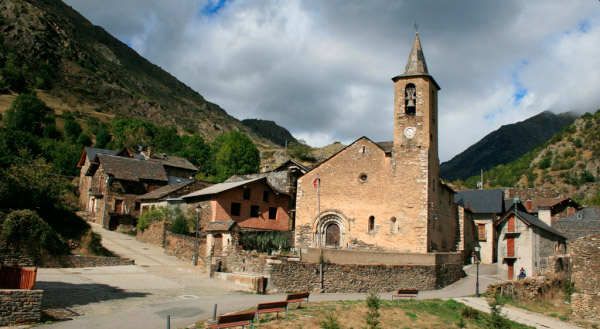
Salardu
Salardu, not far from Arties, is the capital of the eastern part of La Val d’Aran, called Naut Aran. Now it is a satellite town for Baqueira-Beret, a ski resort nearby.
The success of the ski resort has brought many new buildings, but the heart of the village preserves the old houses and steep and narrow streets. Wandering through it, you can smell the cows, sheep, and goats that are the last remnants of the past. The Salardu water mill, recently restored, can be visited. It was used for cutting wood and spinning wool.
Other notable buildings include the 13th century Romanesque Sant Andreu church, a good example of a smooth transition between the Romanesque art of La Val d’Aran and early Gothic art. In the church you can see a 12th century wooden sculpture of the crucified Christ, called Eth Crist de Salardu (this is Occitan, the language in La Val d’Aran which is neither Catalan nor Spanish).
The statue was carved in Erill La Vall, a small village in La Ribargorca, another region in the Catalan Pyrenees. Legend has it that the cross was swept down to Salardu by the Garona river. The village inhabitants, grateful it stopped at their village and not at any of the others it passed, have taken care of it ever since.

Arties
Arties is located in La Val d’Aran. Formerly a thermal village, it was also known for its lead mines and its marble quarries, though tourist activity since has erased all traces of those.
In Arties two rivers join, the Valartiés and the Garona, so the strong noise of the water is always present in the village. It is surrounded by high mountains and deep forests.
Its streets are paved with stone, and its many big houses are made of stone and wood. Most have been very well restored. One example, Casa Paulet, is worth a stop. It is a stately home, with a gothic window on the main façade.
Arties has also two churches, both much transformed over time:
> Santa Maria has many 16th century wall paintings. Its most important element is a gothic arrow.
> Sant Joan, which belonged to the Order of the Hospital of San Juan, harbours a treasure: the Remei Virgin, sculpted in wood in the 12th
Gaspar Portolà house: Other notable features include the Gaspar Portolà house, which nowadays is a Parador Nacional de Turismo (a network of luxury hotels set in historical buildings). Gaspar Portolà discovered California in 1769. The solid square tower built in the 16th Century is still there, with its steep pyramid-shaped slate roof. So is a small chapel dedicated to Sant Antonio, built in 1678.
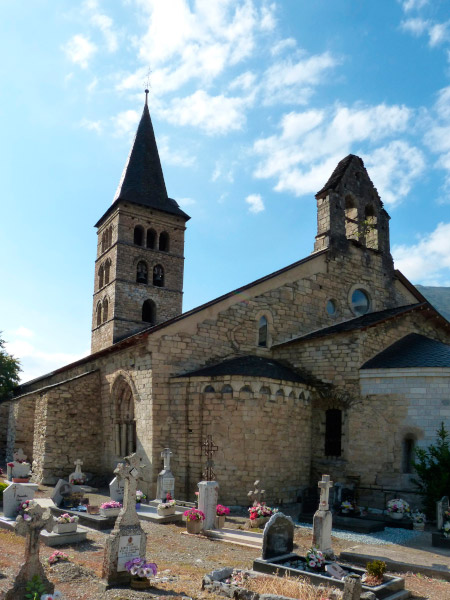
Canejan
Canejan, located at 906m, is the northernmost village in la Val d’Aran.
The village is hooked on to the slope of the Malls mountain, so the streets are narrow and steep, some of them with stairways. Its location is the main attraction – the views are unique and fantastic, looking out over the Toran valley with the Maladeta massif in the background. Aneto, the highest peak in the Pyrenees, is part of this massif. You can clearly distinguish the Aneto’s glacier. I think this is the best view from any village in La Val d’Aran.
For centuries, Canejan inhabitants have made their living from timber, mines, forges, mills and their livestock. They have preserved the beauty of their village and its connection to the surrounding environment, despite the advent of tourism.
There are many signposted trails to walk nearby, including the path to Porcingles, called the Cross trail (Camin des Creus, in Occitan), because it is scattered with wood crosses used at Easter.
A beautiful house in Canejan is Casa Benosa. It has a Romanesque chapel with a bell tower.
Canejan is the northernmost village among the most beautiful villages Pyrenees of this article.
Casa Saurat: Apart from the views, Canejan’s other attraction is Casa Saurat. It is a beautiful 14th century building with a unique square tower, a legacy of the village’s strategic location. The French army has invaded La Val d’Aran many times since the Middle Ages, when La Val d’Aran decided to leave Cominges County for another county that, later on, would become part of Catalonia.

Cardet, Barruera, Coll, Boi, Erill La Vall, Durro, Taull
Cardet (1,193 m), Barruera (1,130 m), Coll (1,180 m), Boi (1,263 m), Erill La Vall (1,246 m), Durro (1,386 m), Taull (1,500 m) must be among the most beautiful villages in the Pyrenees. They all are located in la Vall de Boi (Boi valley), in the Alta Ribagorca County. All are very small; Barruera and Boi have the biggest populations. Villager houses have stone walls, wooden balconies and slate roofs.
They all have Romanesque churches which were designated World Heritage sites by UNESCO in 2000; Boi and Durro each have two.
During the 11th and 12th centuries, many churches were built in La Vall de Boi. Today, we would say that it suffered from the equivalent of a housing bubble. Twenty churches were built in this one small valley of the Pyrenees.
La Vall de Boi is one of the most beautiful places in the Pyrenees. It is to the west of the Aiguestortes National Park and surrounded by high mountains, which make for a fantastic panorama.
The Erill baron decided a thousand years ago to build the churches to thank God for the territory reconquered from the Muslims. He hired the best stone cutters, painters and craftsmen of the time.
All the churches are characterised by their fine-worked stone and graceful bell towers and are considered one of the purest examples of Catalan Lombard Romanesque art which came from the North of Italy.
The first village you encounter when you enter the valley from the south is Coll. Its church is named Santa Maria, well known for its facade.
In Cardet, the next village, the Santa Maria church has a remarkable two-stage apse.
In Barruera there still exist some big houses built in the Middle Ages. The village also has the double-apse Sant Feliu church.
Durro has two churches. The majestic Nativitat church will not leave you indifferent. Even if you do not like the architecture or the Romanesque art, you will surrender to this building. The most outstanding element is the porch.
The other church in Durro, out of the village, is Sant Quirc, small and pretty. It offers a viewpoint of the valley.
The church in Erill la Vall is named Santa Eulalia, and has three clover-shaped apses and a 23m-high six-stage bell tower. Its original wall paintings are now in the MNAC (Museo Nacional d’Art de Catalunya).
Boi has only one church, Sant Joan, built in the 11th Century. The bell tower was added in the 12th Century.
Santa Maria, in Taull, fell prey in 1918 to Franco Steffanoni, an art expert who made off with the wall paintings from the central apse. Nowadays you can see them at the Boston Museum of Fine Arts, a sad absence from the church.
Finally, the crown jewel, also in Taull, Sant Climent. Perhaps the most photographed church in all of the Pyrenees, including France and Andorra. The stylised lines of its 22m-high, six-level bell tower make it a nearly perfect example of Romanesque art.
The other notable elements are the church’s three clover-shape apses, and the wall paintings. Those in the central apse are copies of the originals in the MNAC, but others, including some in the northern apse, are the originals.
Some common characteristics to all the churches: they are characterised by their fine-worked stone and graceful bell towers and are considered among the purest examples of Catalan Lombard Romanesque art which came from the North of Italy.
Please comment below on Most Beautiful Towns and Villages in the Pyrenees.
If you wish to travel to this region and and see the most beautiful towns and villages in the Pyrenees – see what tours we have for you or contact me here for any Pyrenees Tours questions you might have.



